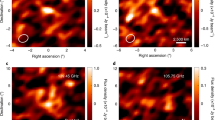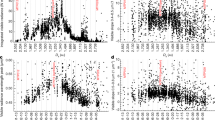Abstract
While the structural complexity of cometary comae is already recognizable from telescopic observations1, the innermost region, within a few radii of the nucleus, was not resolved until spacecraft exploration became a reality2,3. The dust coma displays jet-like features of enhanced brightness superposed on a diffuse background1,4,5. Some features can be traced to specific areas on the nucleus, and result conceivably from locally enhanced outgassing and/or dust emission6,7,8. However, diffuse or even uniform activity over topographic concavity can converge to produce jet-like features9,10. Therefore, linking observed coma morphology to the distribution of activity on the nucleus is difficult11,12. Here, we study the emergence of dust activity at sunrise on comet 67P/Churyumov–Gerasimenko using high-resolution, stereo images from the OSIRIS camera onboard the Rosetta spacecraft, where the sources and formation of the jet-like features are resolved. We perform numerical simulations to show that the ambient dust coma is driven by pervasive but non-uniform water outgassing from the homogeneous surface layer. Physical collimations of gas and dust flows occur at local maxima of insolation and also via topographic focusing. Coma structures are projected to exhibit jet-like features that vary with the perspective of the observer. For an irregular comet such as 67P/Churyumov–Gerasimenko, near-nucleus coma structures can be concealed in the shadow of the nucleus, which further complicates the picture.
This is a preview of subscription content, access via your institution
Access options
Access Nature and 54 other Nature Portfolio journals
Get Nature+, our best-value online-access subscription
$29.99 / 30 days
cancel any time
Subscribe to this journal
Receive 12 digital issues and online access to articles
$119.00 per year
only $9.92 per issue
Buy this article
- Purchase on Springer Link
- Instant access to full article PDF
Prices may be subject to local taxes which are calculated during checkout




Similar content being viewed by others
References
Farnham, T. L. Coma morphology of Jupiter-family comets. Planet. Space Sci. 57, 1192–1217 (2009).
Keller, H. U. et al. First Halley multicolour camera imaging results from Giotto. Nature 321, 320–326 (1986).
Sagdeev, R. Z. et al. The spatial distribution of dust jets seen during the Vega 2 flyby. Astron. Astrophys. 187, 835–838 (1987).
Belton, M. J. Cometary activity, active areas, and a mechanism for collimated outflows on 1P, 9P, 19P, and 81P. Icarus 210, 881–897 (2010).
Farnham, T. L. et al. Connections between the jet activity and surface features on Comet 9P/Tempel 1. Icarus 222, 540–549 (2013).
Yelle, R. V., Soderblom, L. A. & Jokipii, J. R. Formation of jets in Comet 19P/Borrelly by subsurface geysers. Icarus 167, 30–36 (2004).
Combi, M. R. et al. Narrow dust jets in a diffuse gas coma: a natural product of small active regions on comets. Astrophys. J. 749, 29 (2012).
Vincent, J. et al. Are fractured cliffs the sources of cometary dust jets? Insights from OSIRIS/Rosetta at 67P. Astron. Astrophys. 587, A14 (2015).
Crifo, J. F., Rodionov, A. V., Szego, K. & Fulle, M. Challenging a paradigm: do we need active and inactive areas to account for near-nuclear jet activity? Earth Moon Planets 90, 227–238 (2002).
Kramer, T. & Noack, M. On the origin of inner coma structures observed by Rosetta during a diurnal rotation of comet 67P/Churyumov-Gerasimenko. Astrophys. J. 823, L11 (2016).
Crifo, J. F., Fulle, M., Kömle, N. I. & Szego, K. in Comets II 471–503 (The University of Arizona Press, Tucson, 2004).
Fulle, M. et al. Unexpected and significant findings in comet 67P/Churyumov-Gerasimenko: an interdisciplinary view. Mon. Not. R. Astron. Soc. 462, S2–S8 (2016).
De Sanctis, M. C. et al. The diurnal cycle of water ice on comet 67P/Churyumov-Gerasimenko. Nature 525, 500–503 (2015).
Rinaldi, G. et al. Properties of the dust in the coma of 67P/Churyumov–Gerasimenko observed with VIRTIS-M. Mon. Not. R. Astron. Soc. 462, 547–561 (2016).
Hässig, M. et al. Time variability and heterogeneity in the coma of 67P/Churyumov-Gerasimenko. Science 347, aaa0276 (2015).
Fougere, N. et al. Direct Simulation Monte Carlo modelling of the major species in the coma of comet 67P/Churyumov-Gerasimenko. Mon. Not. R. Astron. Soc. 462, 156–169 (2016).
Sierks, H. et al. On the nucleus structure and activity of comet 67P/Churyumov-Gerasimenko. Science 347, aaa1044 (2015).
Thomas, N. et al. The morphological diversity of comet 67P/Churyumov-Gerasimenko. Science 347, aaa0440 (2015).
Lara, L. M. et al. Large-scale dust jets in the coma of 67P/Churyumov-Gerasimenko as seen by the OSIRIS instrument onboard Rosetta. Astron. Astrophys. 583, A9 (2015).
Lin, Z.-Y. et al. Morphology and dynamics of jets of comet 67P/Churyumov-Gerasimenko: early phase development. Astron. Astrophys. 583, A11 (2015).
Keller, H. U. et al. OSIRIS - the scientific camera system onboard Rosetta. Space Sci. Rev. 128, 433–506 (2007).
Sunshine, J. M. et al. Water ice on comet 103P/Hartley 2. EPSC-DPS Joint Meeting 2011 abstr. 1345 (2011).
Prialnik, D., A’Hearn, M. F. & Meech, K. J. A mechanism for short-lived cometary outbursts at sunrise as observed by Deep Impact on 9P/Tempel 1. Mon. Not. R. Astron. Soc. 388, L20–L23 (2008).
Fornasier, S. et al. Rosetta's comet 67P/Churyumov-Gerasimenko sheds its dusty mantle to reveal its icy nature. Science 354, 1566–1570 (2016).
Sunshine, J. M. et al. Exposed water ice deposits on the surface of comet 9P/Tempel 1. Science 311, 1453–1455 (2006).
Keller, H. U. et al. Insolation, erosion, and morphology of comet 67P/Churyumov-Gerasimenko. Astron. Astrophys. 583, A34 (2015).
Hu, X. et al. Thermal modeling of water activity on comet 67P/Churyumov-Gerasimenko with global dust mantle and plural dust-to-ice ratio. Mon. Not. R. Astron. Soc. 469, 295–311 (2017).
Rose, M. Simulation of a complete triple turbo molecular pumping stage using direct simulation Monte Carlo in 3D. AIP Conf. Proc. 1628, 212–219 (2014).
Huebner, W. F. et al. Heat and Gas Diffusion in Comet Nuclei ISSI Scientific Report SR-004 (International Space Science Institute, Bern, 2006).
Migliorini, A. et al. Water and carbon dioxide distribution in the 67P/Churyumov-Gerasimenko coma from VIRTIS-M infrared observations. Astron. Astrophys. 589, A45 (2016).
Shi, X. et al. Sunset jets observed on comet 67P/Churyumov-Gerasimenko sustained by subsurface thermal lag. Astron. Astrophys. 586, A7 (2016).
Hu, X. et al. Seasonal erosion and restoration of the dust cover on comet 67P/Churyumov-Gerasimenko as observed by OSIRIS onboard Rosetta. Astron. Astrophys. 604, A114 (2017).
Bird, G. A. Molecular Gas Dynamics and the Direct Simulation Monte Carlo of Gas Flows (Clarendon Press, Oxford, 1994).
Jorda, L. et al. The global shape, density and rotation of Comet 67P/Churyumov-Gerasimenko from preperihelion Rosetta/OSIRIS observations. Icarus 277, 257–278 (2016).
Fanale, P. & James Salvail, R. An idealized short-period comet model: surface insolation, H2O flux, dust flux, and mantle evolution. Icarus 60, 476–511 (1984).
Marschall, R. et al. Modelling observations of the inner gas and dust coma of comet 67P/Churyumov-Gerasimenko using ROSINA/COPS and OSIRIS data: first results. Astron. Astrophys. 589, A90 (2016).
Preusker, F. et al. Shape model, reference system definition, and cartographic mapping standards for comet 67P/Churyumov-Gerasimenko – stereo-photogrammetric analysis of Rosetta/OSIRIS image data. Astron. Astrophys. 583, A33 (2015).
Werner, R. A. & Scheeres, D. J. Exterior gravitation of a polyhedron derived and compared with harmonic and mascon gravitation representations of asteroid 4769 Castalia. Celest. Mech. Dyn. Astr. 65, 313–344 (1997).
Pätzold, M. et al. A homogeneous nucleus for comet 67P/Churyumov-Gerasimenko from its gravity field. Nature 530, 63–65 (2015).
Grün, E. et al. Mechanisms of dust emission from the surface of a cometary nucleus. Adv. Space Res. 9, 133–137 (1989).
Gombosi, T. I., Nagy, A. F. & Gravens, T. E. Dust and neutral gas modeling of the inner atmospheres of comets. Rev. Geophys. 24, 667–700 (1986).
Acknowledgements
OSIRIS was built by a consortium led by the Max-Planck-Institut für Sonnensystemforschung, Göttingen, Germany, in collaboration with CISAS, University of Padova, Italy, the Laboratoire d’Astrophysique de Marseille, France, the Instituto de Astrofísica de Andalucia, CSIC, Granada, Spain, the Scientific Support Office of the European Space Agency, Noordwijk, The Netherlands, the Instituto Nacional de Técnica Aeroespacial, Madrid, Spain, the Universidad Politéchnica de Madrid, Spain, the Department of Physics and Astronomy of Uppsala University, Sweden, and the Institut für Datentechnik und Kommunikationsnetze der Technischen Universität Braunschweig, Germany. The support of the national funding agencies of Germany (DLR), France (CNES), Italy (ASI), Spain (MEC), Sweden (SNSB) and the ESA Technical Directorate is gratefully acknowledged.
Author information
Authors and Affiliations
Contributions
X.S. led this study, analysed imaging data, performed simulations for gas and dust field modelling, and drafted the manuscript. X.H. contributed to design of the study, performed part of the thermo-physical analysis and contributed to drafting the manuscript. S.M. contributed to the thermo-physical modelling of water activity along dawn terminator and contributed to improving the manuscript. M.R. carried out the development and modification of DSMC code used for cometary coma modelling. H.U.K. and M.F. contributed to interpretation of the results. H.S., C.G. and C.T. participated in early discussions of the study and helped improve the manuscript. S.F., M.P., J.A. and D.B. contributed to improving the manuscript. All remaining authors contributed to the construction, operation and calibration of OSIRIS cameras, which ensured the acquirement of high-quality data used for this study.
Corresponding author
Ethics declarations
Competing interests
The authors declare no competing interests.
Additional information
Publisher’s note: Springer Nature remains neutral with regard to jurisdictional claims in published maps and institutional affiliations.
Supplementary information
Supplementary Information
Supplementary Figures 1–5, Supplementary Table 1, Supplementary Video 1 caption.
Supplementary Video 1
Trajectories of dust particles emitting from the Hapi region observed from a continuously changing perspective.
Rights and permissions
About this article
Cite this article
Shi, X., Hu, X., Mottola, S. et al. Coma morphology of comet 67P controlled by insolation over irregular nucleus. Nat Astron 2, 562–567 (2018). https://doi.org/10.1038/s41550-018-0481-5
Received:
Accepted:
Published:
Issue Date:
DOI: https://doi.org/10.1038/s41550-018-0481-5
This article is cited by
-
Dust-to-Gas and Refractory-to-Ice Mass Ratios of Comet 67P/Churyumov-Gerasimenko from Rosetta Observations
Space Science Reviews (2020)
-
Cometary Comae-Surface Links
Space Science Reviews (2020)
-
Cometary Nuclei—From Giotto to Rosetta
Space Science Reviews (2020)
-
Local Manifestations of Cometary Activity
Space Science Reviews (2019)



